Development of SDN-based wi-fi AP using openwrt and raspberry pi 3
Abstract: We have successfully developed a
prototype of SDN-based Wi-Fi access point device for
IoT communication. The proposed device, that is based
on Raspberry pi 3, uses Linux-based OpenWrt
firmware and Open vSwitch software. It is compatible
with OpenFlow 1.5 and includes one built-in 100 Mbps
Ethernet port. Thanks to taking the advantages of SDN
technology, open source software and low-cost minicomputer, the developed SDN-based device has a
reasonable cost while it is flexible, scalable and still
fully supports advanced network functions. The device
also can be deployed as a network device with various
functions such as hub, switch, firewall, which is
determined by a controlling program installed in the
SDN controller. The AP configuration and its
performance have been verified by testing
experiments. The obtained numerical results proved
the effective and scalable performance of the developed
SDN-based Wi-Fi AP for next generation WLAN and
IoT communication infrastructure.
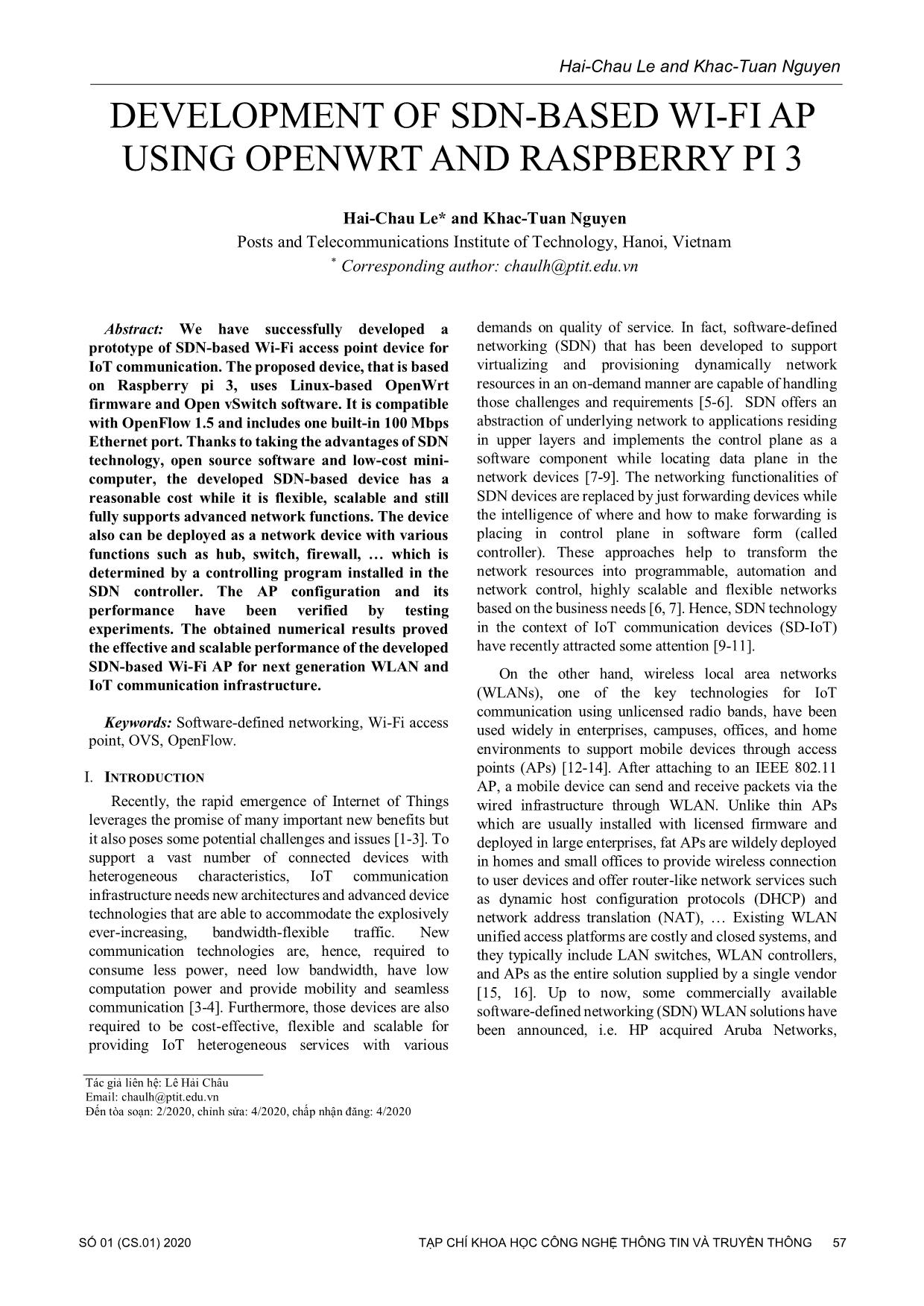
Trang 1
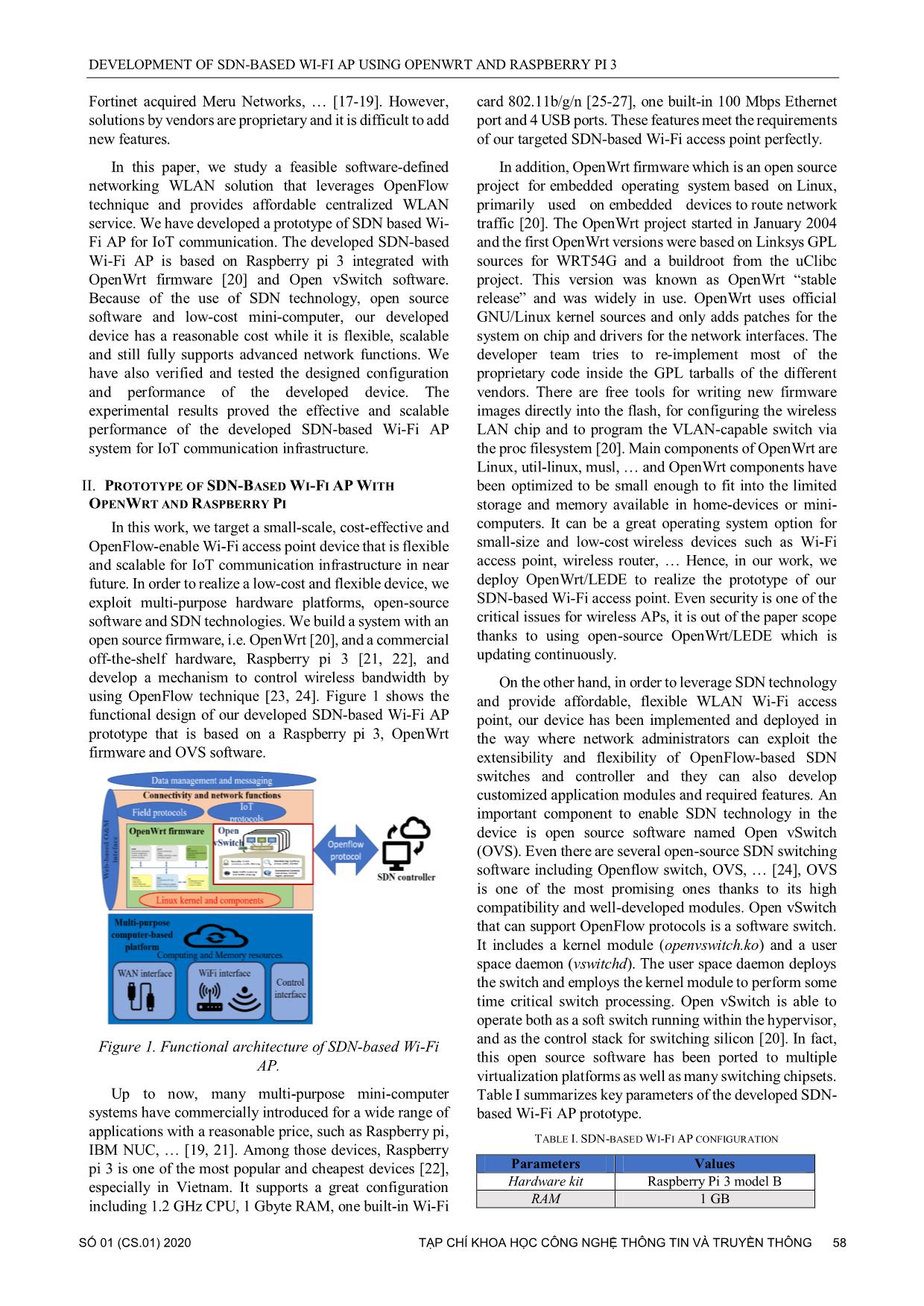
Trang 2
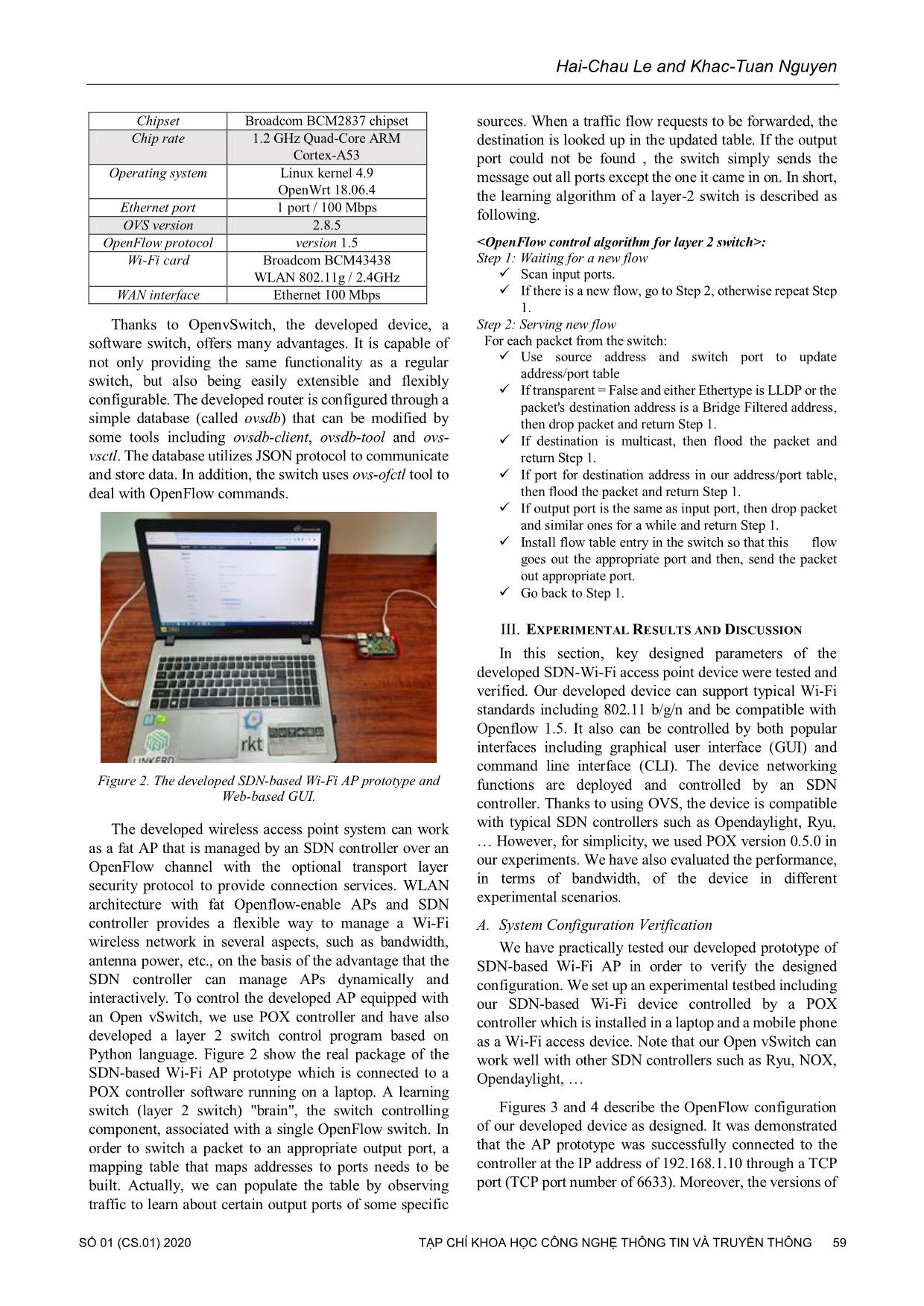
Trang 3
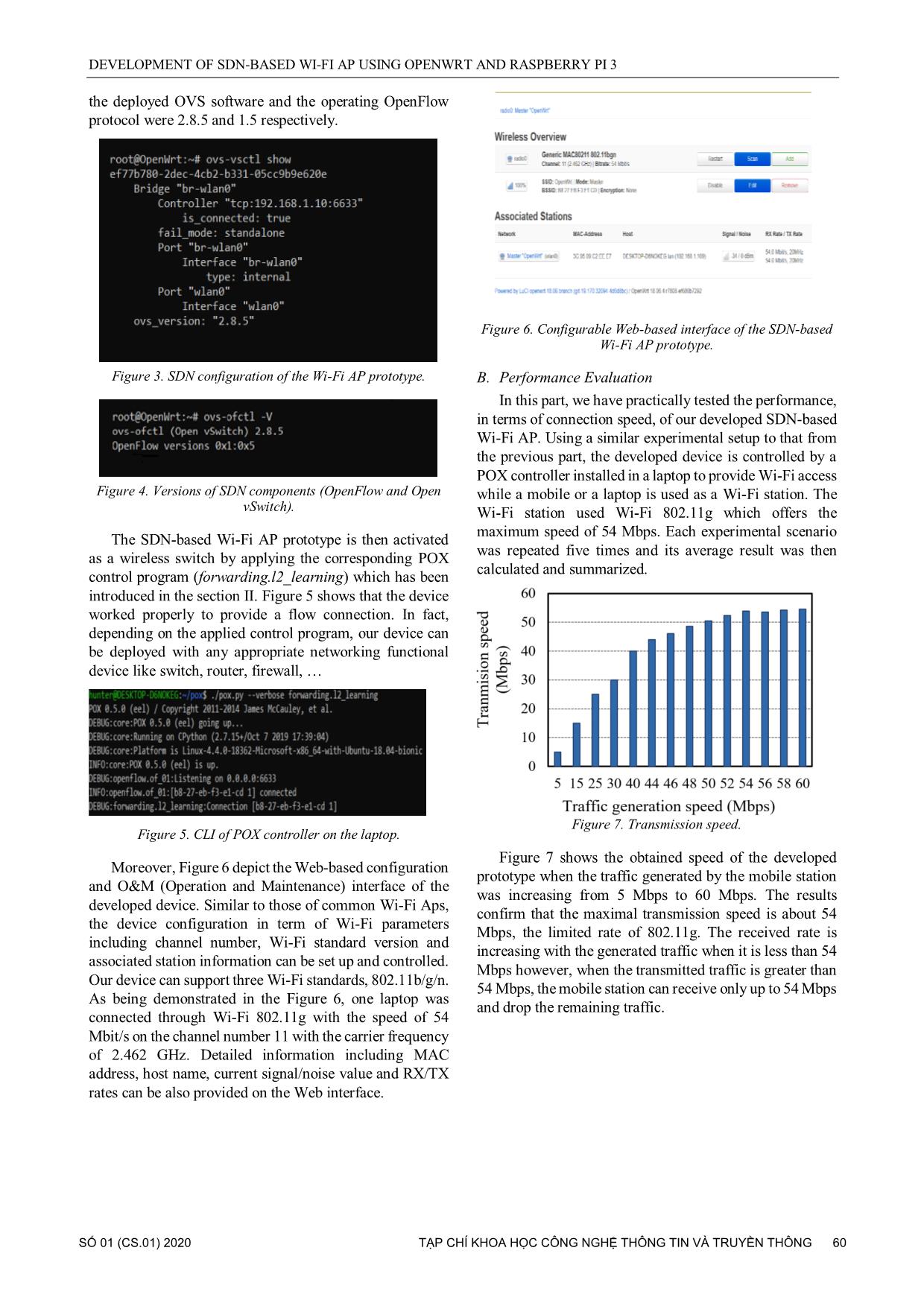
Trang 4
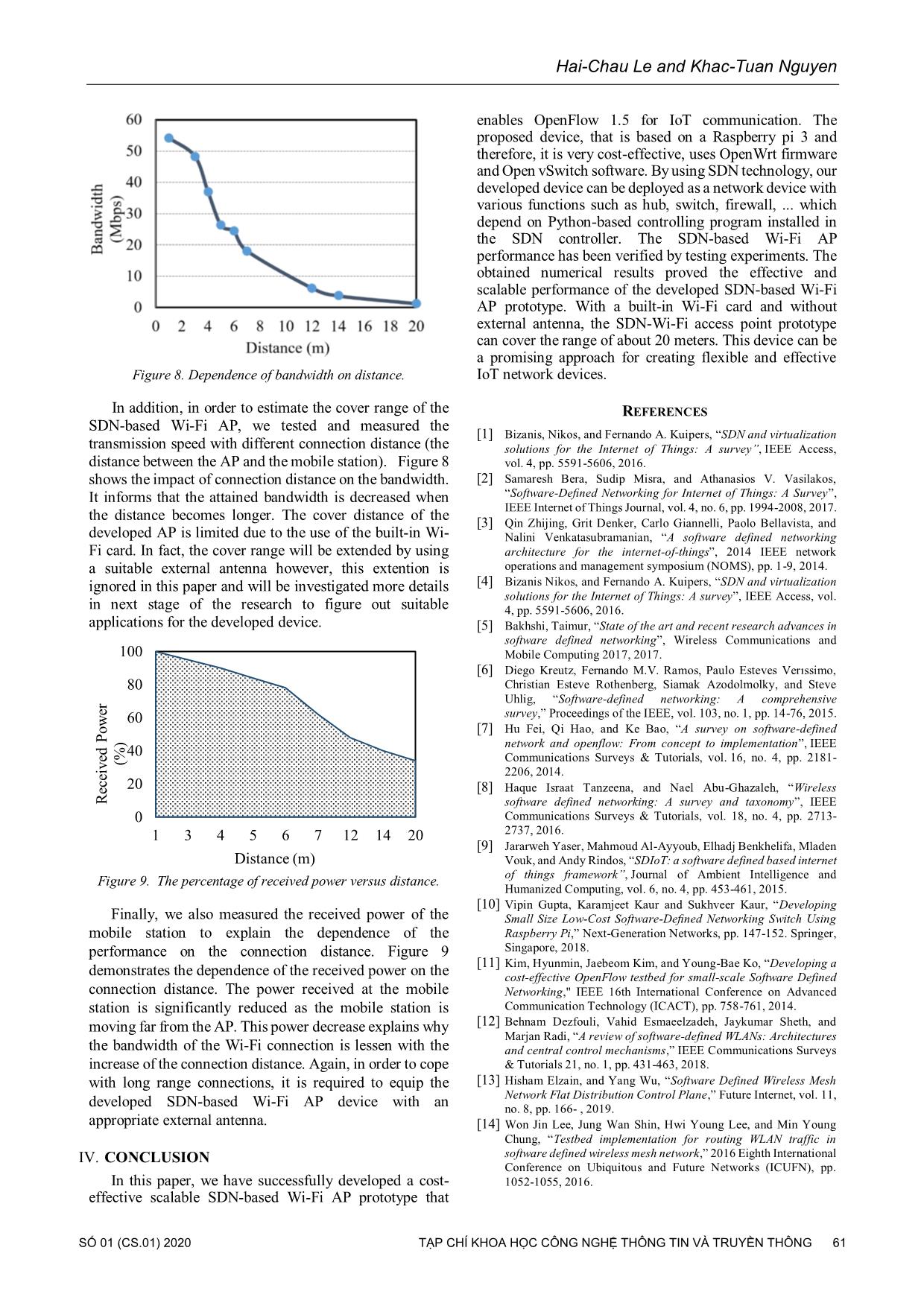
Trang 5

Trang 6
Tóm tắt nội dung tài liệu: Development of SDN-based wi-fi AP using openwrt and raspberry pi 3
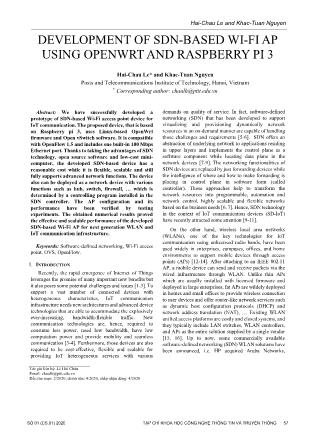
d either Ethertype is LLDP or the packet's destination address is a Bridge Filtered address, then drop packet and return Step 1. If destination is multicast, then flood the packet and return Step 1. If port for destination address in our address/port table, then flood the packet and return Step 1. If output port is the same as input port, then drop packet and similar ones for a while and return Step 1. Install flow table entry in the switch so that this flow goes out the appropriate port and then, send the packet out appropriate port. Go back to Step 1. III. EXPERIMENTAL RESULTS AND DISCUSSION In this section, key designed parameters of the developed SDN-Wi-Fi access point device were tested and verified. Our developed device can support typical Wi-Fi standards including 802.11 b/g/n and be compatible with Openflow 1.5. It also can be controlled by both popular interfaces including graphical user interface (GUI) and command line interface (CLI). The device networking functions are deployed and controlled by an SDN controller. Thanks to using OVS, the device is compatible with typical SDN controllers such as Opendaylight, Ryu, However, for simplicity, we used POX version 0.5.0 in our experiments. We have also evaluated the performance, in terms of bandwidth, of the device in different experimental scenarios. A. System Configuration Verification We have practically tested our developed prototype of SDN-based Wi-Fi AP in order to verify the designed configuration. We set up an experimental testbed including our SDN-based Wi-Fi device controlled by a POX controller which is installed in a laptop and a mobile phone as a Wi-Fi access device. Note that our Open vSwitch can work well with other SDN controllers such as Ryu, NOX, Opendaylight, Figures 3 and 4 describe the OpenFlow configuration of our developed device as designed. It was demonstrated that the AP prototype was successfully connected to the controller at the IP address of 192.168.1.10 through a TCP port (TCP port number of 6633). Moreover, the versions of DEVELOPMENT OF SDN-BASED WI-FI AP USING OPENWRT AND RASPBERRY PI 3 the deployed OVS software and the operating OpenFlow protocol were 2.8.5 and 1.5 respectively. Figure 3. SDN configuration of the Wi-Fi AP prototype. Figure 4. Versions of SDN components (OpenFlow and Open vSwitch). The SDN-based Wi-Fi AP prototype is then activated as a wireless switch by applying the corresponding POX control program (forwarding.l2_learning) which has been introduced in the section II. Figure 5 shows that the device worked properly to provide a flow connection. In fact, depending on the applied control program, our device can be deployed with any appropriate networking functional device like switch, router, firewall, Figure 5. CLI of POX controller on the laptop. Moreover, Figure 6 depict the Web-based configuration and O&M (Operation and Maintenance) interface of the developed device. Similar to those of common Wi-Fi Aps, the device configuration in term of Wi-Fi parameters including channel number, Wi-Fi standard version and associated station information can be set up and controlled. Our device can support three Wi-Fi standards, 802.11b/g/n. As being demonstrated in the Figure 6, one laptop was connected through Wi-Fi 802.11g with the speed of 54 Mbit/s on the channel number 11 with the carrier frequency of 2.462 GHz. Detailed information including MAC address, host name, current signal/noise value and RX/TX rates can be also provided on the Web interface. Figure 6. Configurable Web-based interface of the SDN-based Wi-Fi AP prototype. B. Performance Evaluation In this part, we have practically tested the performance, in terms of connection speed, of our developed SDN-based Wi-Fi AP. Using a similar experimental setup to that from the previous part, the developed device is controlled by a POX controller installed in a laptop to provide Wi-Fi access while a mobile or a laptop is used as a Wi-Fi station. The Wi-Fi station used Wi-Fi 802.11g which offers the maximum speed of 54 Mbps. Each experimental scenario was repeated five times and its average result was then calculated and summarized. Figure 7. Transmission speed. Figure 7 shows the obtained speed of the developed prototype when the traffic generated by the mobile station was increasing from 5 Mbps to 60 Mbps. The results confirm that the maximal transmission speed is about 54 Mbps, the limited rate of 802.11g. The received rate is increasing with the generated traffic when it is less than 54 Mbps however, when the transmitted traffic is greater than 54 Mbps, the mobile station can receive only up to 54 Mbps and drop the remaining traffic. Hai-Chau Le and Khac-Tuan Nguyen Figure 8. Dependence of bandwidth on distance. In addition, in order to estimate the cover range of the SDN-based Wi-Fi AP, we tested and measured the transmission speed with different connection distance (the distance between the AP and the mobile station). Figure 8 shows the impact of connection distance on the bandwidth. It informs that the attained bandwidth is decreased when the distance becomes longer. The cover distance of the developed AP is limited due to the use of the built-in Wi- Fi card. In fact, the cover range will be extended by using a suitable external antenna however, this extention is ignored in this paper and will be investigated more details in next stage of the research to figure out suitable applications for the developed device. Figure 9. The percentage of received power versus distance. Finally, we also measured the received power of the mobile station to explain the dependence of the performance on the connection distance. Figure 9 demonstrates the dependence of the received power on the connection distance. The power received at the mobile station is significantly reduced as the mobile station is moving far from the AP. This power decrease explains why the bandwidth of the Wi-Fi connection is lessen with the increase of the connection distance. Again, in order to cope with long range connections, it is required to equip the developed SDN-based Wi-Fi AP device with an appropriate external antenna. IV. CONCLUSION In this paper, we have successfully developed a cost- effective scalable SDN-based Wi-Fi AP prototype that enables OpenFlow 1.5 for IoT communication. The proposed device, that is based on a Raspberry pi 3 and therefore, it is very cost-effective, uses OpenWrt firmware and Open vSwitch software. By using SDN technology, our developed device can be deployed as a network device with various functions such as hub, switch, firewall, ... which depend on Python-based controlling program installed in the SDN controller. The SDN-based Wi-Fi AP performance has been verified by testing experiments. The obtained numerical results proved the effective and scalable performance of the developed SDN-based Wi-Fi AP prototype. With a built-in Wi-Fi card and without external antenna, the SDN-Wi-Fi access point prototype can cover the range of about 20 meters. This device can be a promising approach for creating flexible and effective IoT network devices. REFERENCES [1] Bizanis, Nikos, and Fernando A. Kuipers, “SDN and virtualization solutions for the Internet of Things: A survey”, IEEE Access, vol. 4, pp. 5591-5606, 2016. [2] Samaresh Bera, Sudip Misra, and Athanasios V. Vasilakos, “Software-Defined Networking for Internet of Things: A Survey”, IEEE Internet of Things Journal, vol. 4, no. 6, pp. 1994-2008, 2017. [3] Qin Zhijing, Grit Denker, Carlo Giannelli, Paolo Bellavista, and Nalini Venkatasubramanian, “A software defined networking architecture for the internet-of-things”, 2014 IEEE network operations and management symposium (NOMS), pp. 1-9, 2014. [4] Bizanis Nikos, and Fernando A. Kuipers, “SDN and virtualization solutions for the Internet of Things: A survey”, IEEE Access, vol. 4, pp. 5591-5606, 2016. [5] Bakhshi, Taimur, “State of the art and recent research advances in software defined networking”, Wireless Communications and Mobile Computing 2017, 2017. [6] Diego Kreutz, Fernando M.V. Ramos, Paulo Esteves Verıssimo, Christian Esteve Rothenberg, Siamak Azodolmolky, and Steve Uhlig, “Software-defined networking: A comprehensive survey,” Proceedings of the IEEE, vol. 103, no. 1, pp. 14-76, 2015. [7] Hu Fei, Qi Hao, and Ke Bao, “A survey on software-defined network and openflow: From concept to implementation”, IEEE Communications Surveys & Tutorials, vol. 16, no. 4, pp. 2181- 2206, 2014. [8] Haque Israat Tanzeena, and Nael Abu-Ghazaleh, “Wireless software defined networking: A survey and taxonomy”, IEEE Communications Surveys & Tutorials, vol. 18, no. 4, pp. 2713- 2737, 2016. [9] Jararweh Yaser, Mahmoud Al-Ayyoub, Elhadj Benkhelifa, Mladen Vouk, and Andy Rindos, “SDIoT: a software defined based internet of things framework”, Journal of Ambient Intelligence and Humanized Computing, vol. 6, no. 4, pp. 453-461, 2015. [10] Vipin Gupta, Karamjeet Kaur and Sukhveer Kaur, “Developing Small Size Low-Cost Software-Defined Networking Switch Using Raspberry Pi,” Next-Generation Networks, pp. 147-152. Springer, Singapore, 2018. [11] Kim, Hyunmin, Jaebeom Kim, and Young-Bae Ko, “Developing a cost-effective OpenFlow testbed for small-scale Software Defined Networking," IEEE 16th International Conference on Advanced Communication Technology (ICACT), pp. 758-761, 2014. [12] Behnam Dezfouli, Vahid Esmaeelzadeh, Jaykumar Sheth, and Marjan Radi, “A review of software-defined WLANs: Architectures and central control mechanisms,” IEEE Communications Surveys & Tutorials 21, no. 1, pp. 431-463, 2018. [13] Hisham Elzain, and Yang Wu, “Software Defined Wireless Mesh Network Flat Distribution Control Plane,” Future Internet, vol. 11, no. 8, pp. 166- , 2019. [14] Won Jin Lee, Jung Wan Shin, Hwi Young Lee, and Min Young Chung, “Testbed implementation for routing WLAN traffic in software defined wireless mesh network,” 2016 Eighth International Conference on Ubiquitous and Future Networks (ICUFN), pp. 1052-1055, 2016. 0 20 40 60 80 100 1 3 4 5 6 7 12 14 20 R ec ei v ed P o w er (% ) Distance (m) DEVELOPMENT OF SDN-BASED WI-FI AP USING OPENWRT AND RASPBERRY PI 3 [15] Kristián Košťál, Rastislav Bencel, Michal Ries, Peter Trúchly, and Ivan Kotuliak, “High Performance SDN WLAN Architecture,” Sensors, vol. 19, no. 8, pp. 1880- , 2019. [16] Ahmed Abdelaziz, Ang Tan Fong, Abdullah Gani, Suleman Khan, Faiz Alotaibi, Muhammad Khurram Khan, “On Software-Defined Wireless Network (SDWN) Network Virtualization: Challenges and Open Issues”, The Computer Journal, Volume 60, Issue 10, pp. 1510–1519, October 2017. [17] Hsu, Huai‐Wen, Kuei‐Li Huang, Yi‐Chih Kao, Shi‐Chun Tsai, and Yi‐Bing Lin, “Deploying WLAN service with OpenFlow technology”, International Journal of Network Management 27, no. 3, pp. e1970, 2017. [18] Alshnta, Abdalkrim M., Mohd Faizal Abdollah, and Ahmed Al- Haiqi, “SDN in the home: A survey of home network solutions using Software Defined Networking”, Cogent Engineering 5, no. 1, pp. 1469949, 2018. [19] Miano Sebastiano, and Fulvio Risso, “Transforming a traditional home gateway into a hardware-accelerated SDN switch”, International Journal of Electrical and Computer Engineering 10, no. 3, pp. 2668, 2020. [20] OpenWrt offical homepage, https://openwrt.org/ [21] John C. Shovic, “Raspberry pi IoT projects,” Apress, 2016. [22] “Raspberry Pi Foundation.”, https://www.raspberrypi.org/ [23] https://openflow.stanford.edu/display/ONL/POX+Wiki.html [24] OpenvSwitch Offical Homepage, https://openvswitch.org [25] https://standards.ieee.org/standard/802_11-2012.html [26] 802.11-2012 - IEEE Standard for Information technology– Telecommunications and information exchange between systems Local and metropolitan area networks–Specific requirements Part 11: Wireless LAN Medium Access Control (MAC) and Physical Layer (PHY) Specifications. Tech. Rep. IEEE Std 802.11TM-2012, IEEE-Inst. [27] Wi-Fi Alliance, NGHIÊN CỨU PHÁT TRIỂN HỆ THỐNG TRUY NHẬP WI-FI ĐỊNH NGHĨA BẰNG PHẦN MỀM SỬ DỤNG RASPBERRY PI 3 VÀ OPENWRT Lê Hải Châu và Nguyễn Khắc Tuấn Học viện Công nghệ Bưu chính Viễn thông * Email liên hệ: chaulh@ptit.edu.vn Tóm tắt: Trong bài báo này, chúng tôi đã nghiên cứu và phát triển thành công một mẫu thiết bị truy nhập Wi-Fi định nghĩa bằng phần mềm cho truyền thông IoT. Thiết bị được phát triển dựa trên nền tảng Raspberry pi 3, sử dụng firmware OpenWrt dựa vào nhân Linux và phần mềm chuyển mạch SDN mã nguồn mở Open vSwitch. Hệ thống này có khả năng tương thích với giao thức OpenFlow 1.5 và hỗ trợ giao diện WAN qua một cổng Ethernet dựng sẵn 100 Mbps. Nhờ việc khai thác các ưu điểm của công nghệ SDN, công nghệ mã nguồn mở và nền tảng máy tính cỡ nhỏ giá thành rẻ, mẫu thiết bị truy nhập Wi-Fi định nghĩa bằng phần mềm có giá thành chấp nhận được trong khi vẫn rất linh hoạt, có khả năng mở rộng tốt và cho phép hỗ trợ đầy đủ các tính năng mạng tiên tiến. Thiết bị này cũng có thể được triển khai thành các thiết bị mạng với các tính năng khác nhau như hub, switch, router hay firewall, bằng cách sử dụng phần mềm điều khiển được lập trình và cài đặt trên bộ điều SDN. Cấu hình và hiệu năng của mẫu thiết bị này được kiểm thử và xác minh thông qua các thí nghiệm đo kiểm. Các kết quả đạt được đã thể hiện sự hiệu quả và khả năng mở rộng linh hoạt của thiết bị được phát triển. Từ khoá: Mạng định nghĩa bằng phần mềm, điểm truy nhập Wi-Fi, OVS, OpenFlow. Hai-Chau Le received the B.E. degree in Electronics and Telecommunications Engineering from Posts and Telecommunications Institute of Technology (PTIT) of Vietnam in 2003, and the M.Eng. and D.Eng. degrees in Electrical Engineering and Computer Science from Nagoya University of Japan in 2009 and 2012, respectively. From 2012 to 2015, he was a researcher in Nagoya University of Japan and in University of California, Davis, USA. He is currently a lecturer in Telecommunications Faculty at PTIT. His research interests include optical technologies, network design and optimization and future network technologies. He is an IEEE member. Khac-Tuan Nguyen is a 5th year bachelor student in the field of Electronics and Telecommunications Engineering at Posts and Telecommunications Institute of Technology of Vietnam, and is currently an active member of Information network research group of Telecommunications Faculty I in PTIT. His research interests include SDN, NFV, and future network technologies.
File đính kèm:
 development_of_sdn_based_wi_fi_ap_using_openwrt_and_raspberr.pdf
development_of_sdn_based_wi_fi_ap_using_openwrt_and_raspberr.pdf

